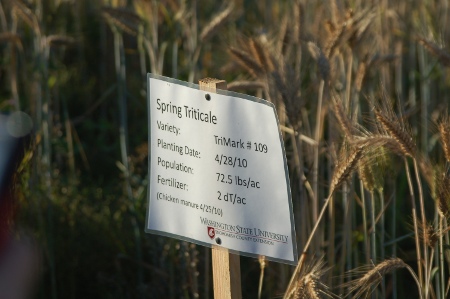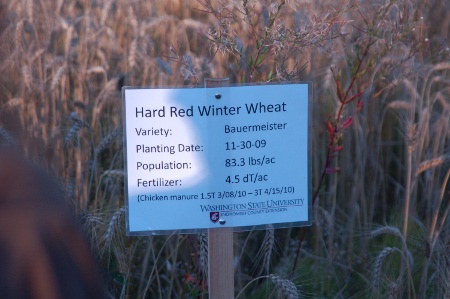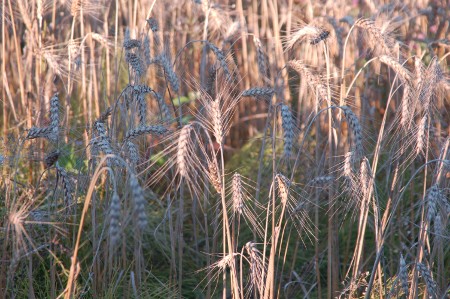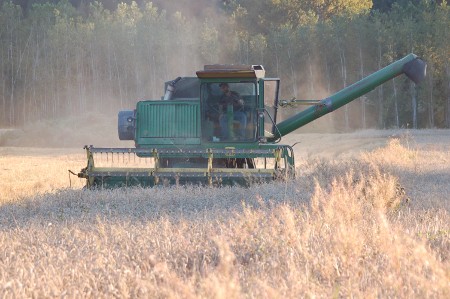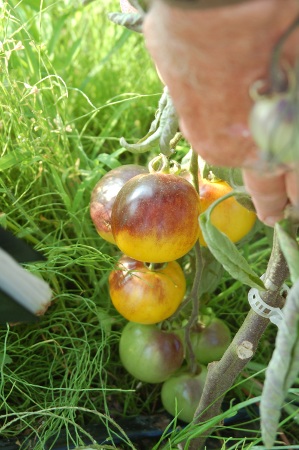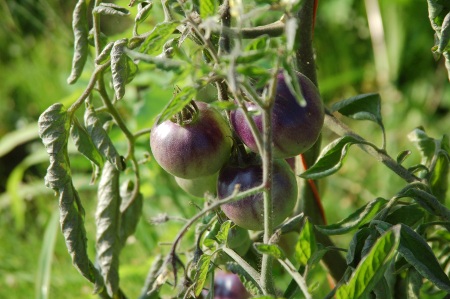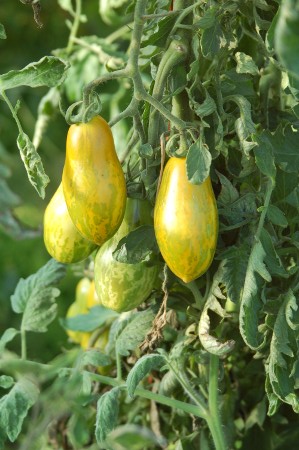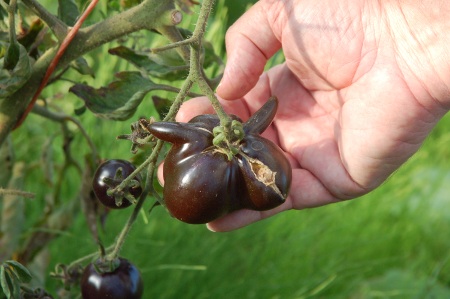Tom Wagner has a new blog. It’s just getting started, so have some patience, but please stop by and have a look.
Genetic Sequence for Late Blight Resistant Tomatoes Cracked?
Until now not much luck has been had in breeding late blight resistance into tomatoes. A number of people have tried, but in general either the plants have late blight resistance but don’t produce interesting tomatoes, or they lose their blight resistance as they are bred to produce nicer tomatoes. A few good quality tomatoes have been developed with some late blight resistance, but their resistance is spotty and generally very geographically localized. As late blight inevitably evolves, these tomatoes lose their resistance.
Four genes have been identified that seem to be related to late blight resistance: Ph-0, Ph-1, Ph-2 and Ph-3. It was pretty quickly determined Ph-0 and Ph-1 didn’t really offer much long term resistance, so now people’s attention are on Ph-2 and Ph-3. Like I just said, until now there’s been some interaction between these and other genes, that seems to prevent a good quality tomato from being developed with late blight resistance.
Last year Tom Wagner bred a tomato with both Ph-2 and Ph-3 genes called Skykomish. What was unusual about this tomato was the Ph-2 and Ph-3 genes were homozygous. What this means is since genes are always in pairs, each half being inherited from one parent, the Ph-2 and Ph-3 late blight resistant genes in these tomatoes were inherited from both parents and existed as an identical pair.
The results last year were spectacular! I will try to find a copy of the picture to link to or post, but late blight came through a field of Tom’s tomatoes, destroying every one, except leaving his Skykomish plant standing unscathed. I want to be clear, this is a good tasting high quality tomato.
This year, Tom has been trying to verify that late blight resistance does in fact depend on the genes being homozygous, and the results look very promising so far. Tom recently posted the following in his discussion forum:
There is one area where I plant tomatoes every year. It is usually the first to come down with late blight and of course, I do not every spray for control. I think the blight is fully entrenched in the soil here and no effort is made to clean up the debris in any year.
It appears that Ph-2 and Ph-3 are still operative in controlling the outbreak.
Make My Day is one that has both the Ph-2 and Ph-3 gene in a homozygous pairing. No blight
Matt’s Wild is homozygous for Ph-2. No blight.
The tomato hybrids that have Ph-2 from one parent have slight resistance to the foliage, but not as much control on the fruit as I would like.
Hybrids with Skykomish which is homozygous for Ph-2 and Ph-3 have slight resistance.
I will check the progress as the blight burns through. It started about three days ago.
With many, many hybrids of these lines being put away as F-2 seed, a fuller evaluation for 2011 will be to look for segregations that are true breeding for the best blight resistance/tolerance. Homozygous traits need to be found in every time of tomato, whether is a red, bi-color, green, striped, black, yellow, etc.
Tom Wagner
There’s still some work to be done to verify the resistance, but it looks pretty good so far. Next year I will grow the Skykomish in Europe, and see how it stands up to the blight here.
Tom Wagner Visit, Part 2
A number of Tom’s tomato and potato growing trials are hosted by Chinook Farms CSA, in western Washington State. As it turned out during the first evening of my visit a number of grain related presentations and demonstrations were hosted onsite.
Western Washington isn’t an area with a lot of grain farms. It’s mostly considered unsuitable for grains, but Eric Fritch and his wife who run Chinook Farms CSA are trying to change that. They feel there is a market in the area for small scale artesian grains to be grown, and in effect they are trying to get grain farming in the area started from scratch.
Their farmland previously had cedar trees, I guess grown for lumber or other wood materials. These were recently cleared to make room for the farm, but this left the ground very nitrogen poor. Grains need nitrogen in order to build up protein in the grain. Grains need a minimum protein content to be suitable for breads, and without enough protein the grains can only be sold as animal feed.
However, a high nitrogen fertilizer given too early in the plant life-cycle of the grains, will result in more seed heads and poorer quality grain. Therefore if fertilizer is to be added, it has to be added later, after the seed heads have formed. Part of these trials was therefore to test when and how much nitrogen to apply and at what stage in plant development. This is why you see this so clearly displayed on the signs.
One of the problems discussed during this evening’s presentations was a lack of locally available grain processing equipment, especially suited for small scale production.
They demonstrated the combine used on the farm, something that was bought used for around US$4000, I think. It was pointed out that anyone trying to do something with grains on a less-than-farm scale, wouldn’t be able to use something like that. For example, someone with a large suburban lot garden. How are you going to get something like that up your driveway?
It turns out there are smaller combines available on the market, but the cost is roughly 10 times that of the larger one and they have to be imported from Italy. Since such a machine would only be used for a few hours per year, it would be a hard purchase to justify for the average person.
Also discussed was the need for grain processing equipment like hullers, which also have similar high costs together with a relatively few number of hours of use per year.
It all makes growing grains on a small scale very expensive, unless a number of farmers and small scale growers work together and share costs.
A combine has 1 million moving parts, and makes quite a bit of noise and stirs up a lot of dust as it goes!
One of the things Tom and I talked about was his interest in getting into breeding of grains. In particular, he talked about the problems of getting old varieties of grains out of gene banks.
If you make a request for a sample of an old grain from a genebank, as a rule they will only give you a few grams. If you grow this sample, after the first year if all goes well, you’ll probably have several hundred grams. If you regrow this, a few kilograms after the second year. So it won’t be until the 3rd or even 4th year of regrowing these samples that you will have enough to do a proper trial, and if you have a crop failure in the meantime you have to start over.
Doing these initial plantings and replantings is quite expensive and labor intensive. It’s requires a lot of personal care and attention, and like I talked about above involves a lot of short term use of expensive equipment, as well as probably a lot of manual harvesting with a scythe.
For older varieties that can be purchased in bulk, and there are a few of these, this is a possible alternative. Most of the older varieties however are not available for bulk purchase, and neither is it economically feasible to make these available for sale.
If someone doesn’t take it upon themselves to do or fund these initial grow-outs of old grain varieties, it won’t be possible in 5-10 years time to be able to do trials and commercial scale plantings of old grain varieties. This is just a fact.
Tom Wagner Visit, Part 1
Certainly one of the highlights of my recent visit to the US was seeing Tom Wagner, and some of his trial gardens.
I spent most of two days with Tom, and while I saw so much and spent a lot of time talking with Tom, I have two main sets of pictures in my camera, so I will split these over two posts.
This first post is on the various lines of tomatoes I saw. Wow, Tom is really working on a number of exciting lines of tomatoes!
Tom has been doing a lot of work recently with both blue tomatoes and blight resistance, as well as lots of other things like his well known Green Zebra tomato and related lines and crosses.
One of the things you may notice in these pictures of blue tomatoes, are the degree of blue color. One of the things I find interesting about the blue color, is it’s primarily a reaction to sunlight that the tomatoes turn blue. So, if the tomatoes have this gene, they won’t develop much of the color unless the fruit itself is exposed to a lot of light.
Another characteristic of the blue is it protects the tomatoes against sunscald! I’ve started to notice sunscald on my tomatoes over the last couple of years, and I think it’s the result of thinning ozone over Europe. This is the first I’ve heard of tomatoes being resistant to sunscald, and I think this is the kind of trait that could become important as climate change becomes more of a reality.
The blue lines are also rich in anthocyanins, and probably other nutrients, which are increasingly being lost in our modern diet lacking in colors.
In my opinion, this was one of the more exciting lines Tom was working on, a blue cherry tomato. Rich in anthocyanins, and well suited for making a sort of dried tomato-raisin as well as sauces and other things.
Here’s a blue line that still has a few undesirable genes… Would you buy a tomato that had devil’s horns? I think this is one of the earlier blue lines Tom is working with.
Buying Tulip Bulbs in Japan
~xfer just made an interesting post about buying tulip bulbs in Japan. Wow, the luxury of being able to buy the bulbs one at a time!


